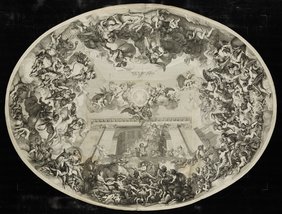Among the ca. 200 large-format prints of the collection A. Haupt are a series of magnificent copper engravings depicting impressive vault and wall frescoes of famous Italian and French palaces. Among them is a work printed from five plates showing the composition The Palace of the Sun by Charles Le Brun (1619–1690), engraved by Gerard Audran (1640–1703):
Apollo enthroned in front of his palace; surrounded by the seasons, months and hours bound together in the circle of the year by the serpent biting its tail, he receives the light-flooded coat of arms of the French king. The gods of Olympus are present, Mars and Jupiter crown the coat of arms, Saturn supports it with his body and Aurora serves as mediator to the god of light.
But what appears here as the glorification of the French king Louis XIV and seems to fit into his excessively celebrated staging of power as the Sun King, was originally intended for someone else. Nicolas Fouquet (1615–1680), Surintendant des Finances and one of the most powerful men in absolutist France before Louis XIV took power, commissioned Charles Le Brun to decorate his castle, Vaux-le Vicomte. For the painting of the gigantic dome of the central room, the Grand Salon Ovale, Le Brun designed the Palace of the Sun. Surviving drawings in the Louvre and contemporary descriptions of the iconography provide information about the original conception with Fouquet's squirrel crest in the centre. But the project, which was to have been one of the most impressive ceiling frescoes of the French Baroque, was never executed in painting. Shortly after Louis XIV took power in 1661, Fouquet was deposed and arrested, work in the palace came to a halt, and the artists were summoned to Versailles by the king.
Even though the abandonment of the work was not to Charles Le Brun's detriment – his successful career at the court of Louis XIV began at this point – he obviously did not want to give up his work and arranged for it to be executed in engraving by Gérard Audran. Provided with a dedication and the change of the coat of arms, Le Brun probably also offered his work to the king in the hope of being able to realise it elsewhere, for example in the Louvre.
This did not happen. However, a digital reconstruction and projection based on the drawings and the present print is planned for this year at its originally intended place of installation, the oval dome in Vaux-le Vicomte.
br

